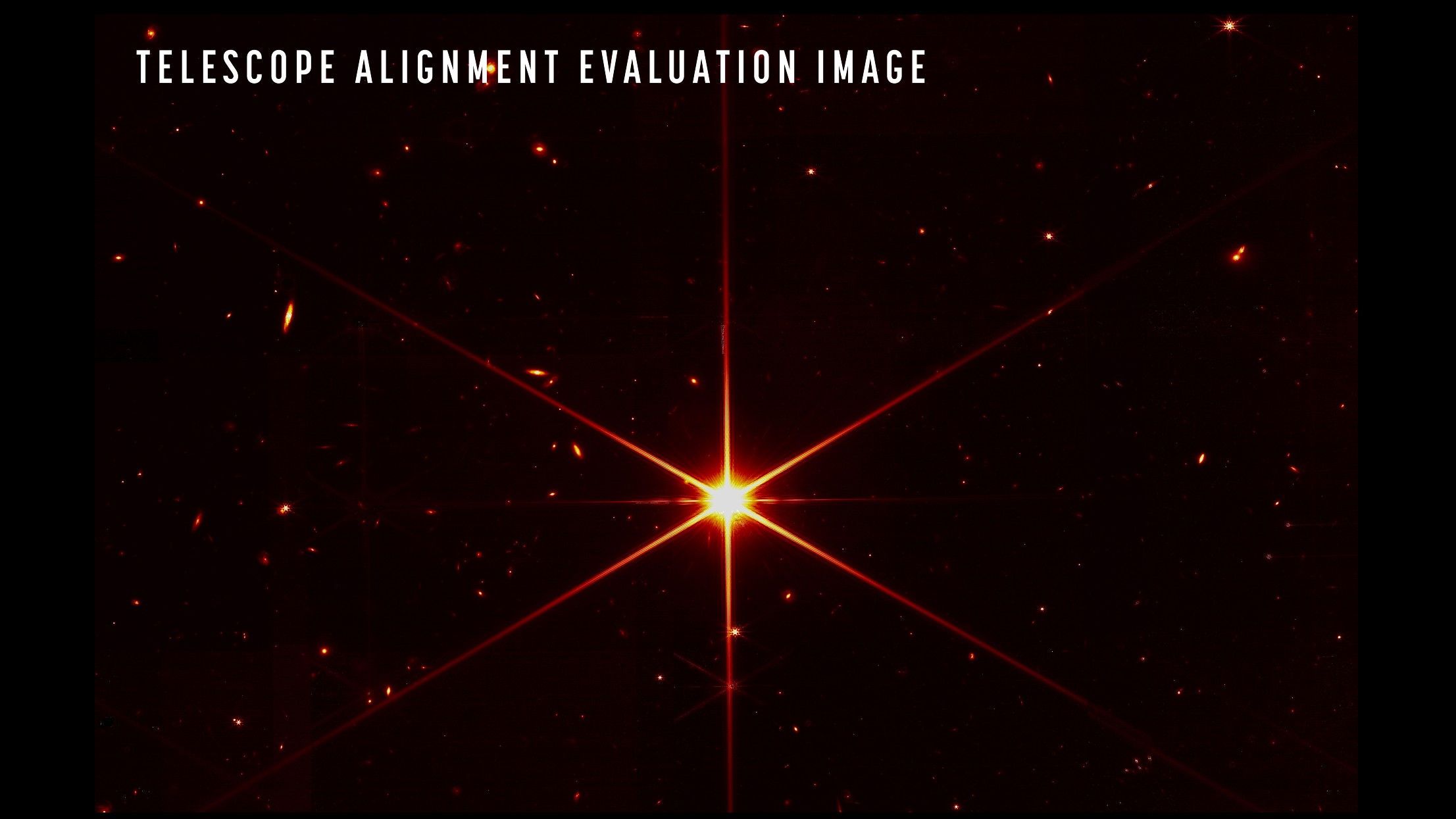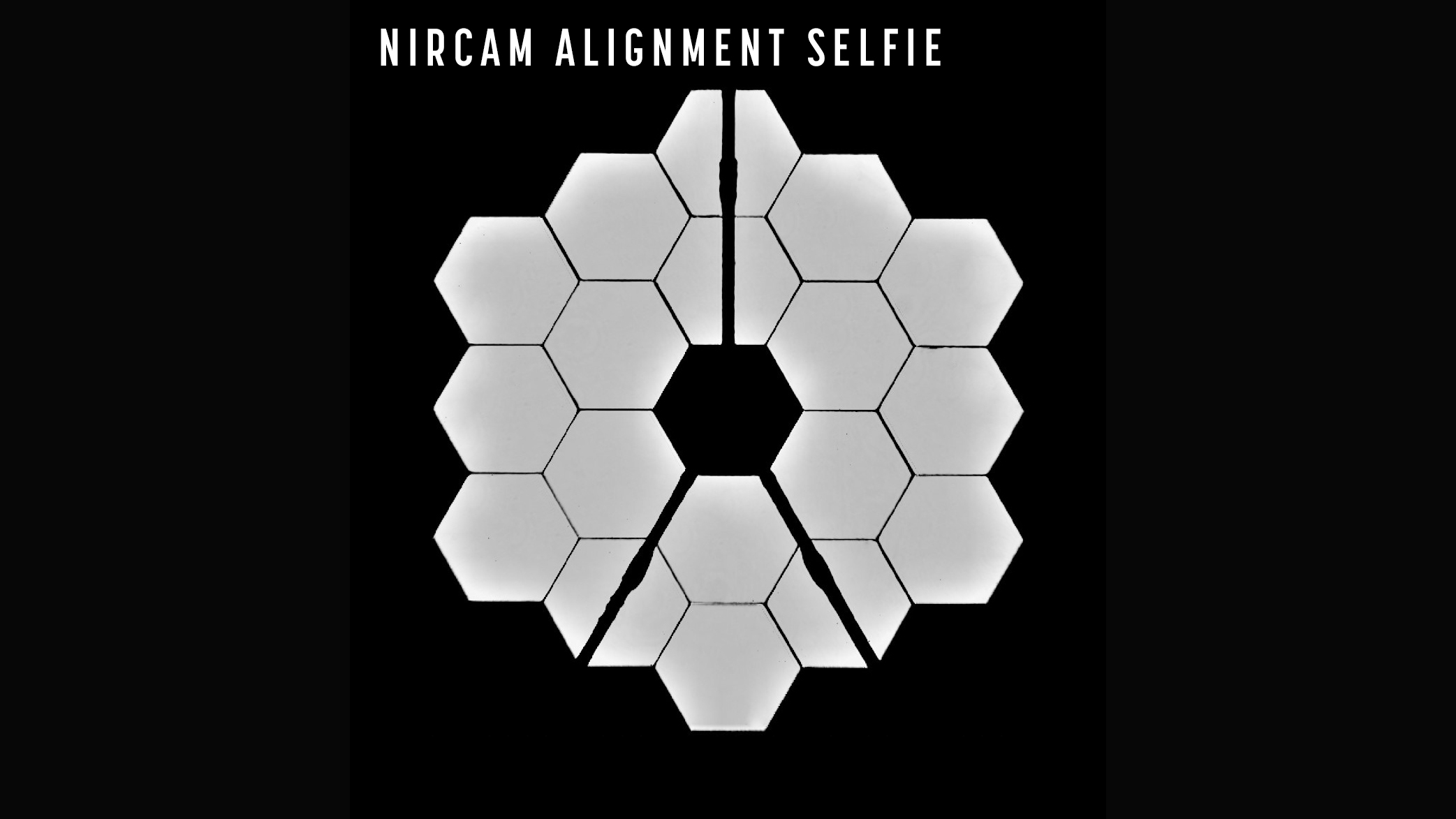1st image snapped by iconic Webb telescope pushes limits of the 'laws of physics'
The photo is even better than scientists hoped it would be.

The James Webb Space Telescope (Webb) has released its first sharp image and it is a doozy — a spectacular view of a twinkling orange star that is focused with such sharpness that it pushes the limits of the laws of physics.
The image shows that the telescope's 18 separate mirrors are now accurately aligned and acting as one, and the photo is even better than scientists hoped it would be, NASA officials said in a statement.
The Webb team released the photograph of the Milky Way star, designated 2MASS J17554042+6551277 and located roughly 2,000 light-years away, Wednesday (March 16). It was taken with a red filter to maximize the visual contrast between the star and the blackness of space, while dozens of other stars and distant galaxies can be seen in the background.
Here's more info on the @NASAWebb field. Can ID only one galaxy at z=0.285, the rest don't have spectroscopic redshifts. Deepest optical image I can find is Pan-STARRS. The milky way star distance is 1,995 light years from @ESAGaia. I've added some labels for @marinakoren et al. pic.twitter.com/AJ3nflJ4qEMarch 16, 2022
According to BBC News, the image shows that the optical systems of the new space telescope are now working better than the scientists and engineers had hoped.
"You not only see the star and the spikes from the diffraction of the star, but you see other stars in the field that are tightly focused, just like we expect, and all sorts of other interesting structure in the background," Webb engineer Lee Feinberg told reporters at the NASA news conference Wednesday. "We've actually done very detailed analysis of the images we're getting, and so far, what we're finding is that the performance is as good [as], if not better than, our most optimistic prediction."
The image is the result of the "fine phasing" stage of the mirror alignments, in which every optical parameter is checked to verify that the telescope can successfully gather light from distant objects, NASA said in the statement.
Mirror alignment
Feinberg has led the project to align the space telescope's 18 hexagonal beryllium mirrors so they function as one nearly hexagonal mirror with a diameter of 21.3 feet (6.5 meters). The design allowed the system of mirrors to be folded and fit inside a rocket fairing at launch — unlike Webb's predecessor, the Hubble Space Telescope, which has just one main mirror that's about 7.8 feet (2.4 m) across.
Sign up for the Live Science daily newsletter now
Get the world’s most fascinating discoveries delivered straight to your inbox.
One of the first photographs from Webb, released last month, showed 18 images of a single star in a hexagonal pattern — one from each separate mirror, which by then had been roughly aligned to point at the same location.
The new image shows the unfolded mirrors have been adjusted to within nanometers, resulting in a single image in sharp focus, scientists said at the news conference.
"We now have achieved what's called 'diffraction limited alignment' of the telescope," Marshall Perrin, Webb deputy scientist at the Space Telescope Science Institute in Baltimore, said at the news conference. "The images are focused together as finely as the laws of physics allow."

When light goes through a lens, it forms a central image and then a circle of "diffraction rings" around it like a bullseye. The diffraction limit, which is based on the wavelength, the lens power and the distance from the object you're measuring, tells you how close together two objects or features can be before a telescope with a perfect lens can no longer tell them apart.
And the latest test photograph is already better than Hubble could have produced.
"The engineering images that we see today are as sharp and as crisp as the images that Hubble can take but are at a wavelength of light that is totally invisible to Hubble," said Jane Rigby, operations project scientist for Webb at NASA's Goddard Space Flight Center in Greenbelt, Maryland. "So this is making the invisible universe snap into very, very sharp focus."
Future photographs
The next stage of the project will be to refine the alignment and bring several of the space telescope's instruments online, according to the NASA statement.
They include the Near-Infrared Spectrograph, which will examine the light spectra from distant objects to learn more about their physical properties, such as their temperature and chemical composition; the Mid-Infrared Instrument, which is both a camera and a spectrograph that captures images in wavelengths the eye can't see; and the Near-Infrared Imager and Slitless Spectrograph, a very precise instrument that will look for and investigate orbiting exoplanets.
The next stage will take about six weeks and will be followed by a final alignment stage in which the Webb team will adjust any residual positioning errors in the mirror segments.
The Webb team says it's on track to complete work on the telescope's entire optical system by early May, which will be followed by another two months of instrument preparation; the space telescope could start producing its first full high-resolution imagery and science data in the summer, the statement said.
The $10 billion James Webb Space Telescope is a collaboration among NASA, the European Space Agency and the Canadian Space Agency. It's named after former NASA Administrator James E. Webb, who led the agency during the Mercury, Gemini and much of the Apollo space programs.
The space telescope launched on Dec. 25, 2021, after years of technical delays. It arrived in late January at the L2 Lagrange point of the sun-Earth system, about 930,000 miles (1.5 million kilometers) away, where gravity balances out centrifugal forces.
Scientists expect that Webb will be able to image distant objects up to 100 times too faint for the Hubble Space Telescope to see and that it will last 10 to 20 years, when the fuel for the thrusters that keep it in position will run out.
Originally published on Live Science.
Tom Metcalfe is a freelance journalist and regular Live Science contributor who is based in London in the United Kingdom. Tom writes mainly about science, space, archaeology, the Earth and the oceans. He has also written for the BBC, NBC News, National Geographic, Scientific American, Air & Space, and many others.










